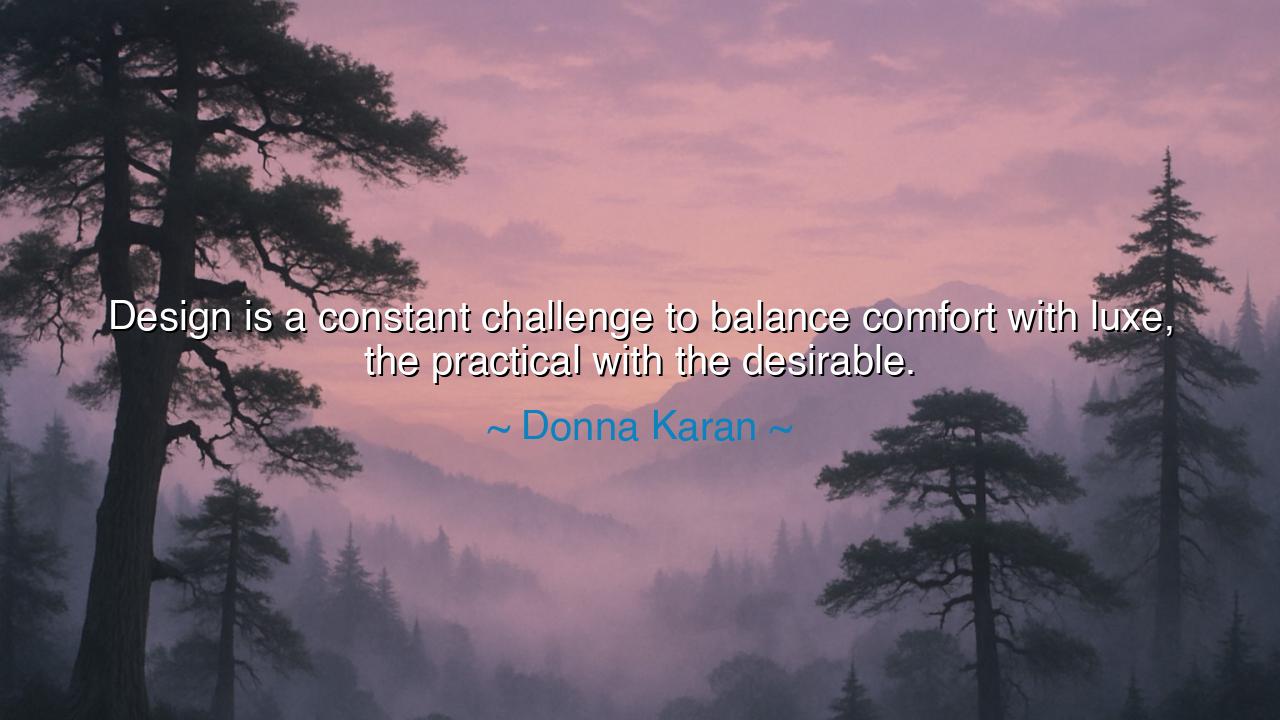
Design is a constant challenge to balance comfort with luxe, the
Design is a constant challenge to balance comfort with luxe, the practical with the desirable.






The great fashion designer Donna Karan, whose creations shaped the modern language of elegance, once spoke with rare honesty about the heart of her craft: “Design is a constant challenge to balance comfort with luxe, the practical with the desirable.” In these words, she captures not only the struggle of fashion but the very paradox of human life — the eternal tension between what we need and what we dream. To design, she reminds us, is not to choose one side over the other, but to live in the sacred space between opposites: between comfort and luxury, function and beauty, necessity and aspiration.
Donna Karan’s insight was born of her own journey. Rising from the ateliers of New York to the heights of international fame, she built her brand not upon extravagance, but upon empathy. She looked at the lives of working women — mothers, thinkers, creators — and saw their exhaustion with impractical beauty. Her “Seven Easy Pieces” collection in 1985 revolutionized the way women dressed. It was simple, functional, elegant — clothing that could move from office to evening with ease. Here, Karan achieved what she called the balance: clothes that honored both the real and the ideal. Her philosophy was not to adorn women, but to empower them — to make design an act of harmony between their lives and their dreams.
This principle echoes the wisdom of the ancients, who sought the middle path in all creation. The Greeks spoke of sophrosyne, the virtue of balance and moderation — the ability to hold opposites in unity. The sculptors of Athens, when carving the human form, married strength with grace; the architects of Rome built arches that were both enduring and beautiful. Even in Eastern thought, the Tao teaches that yin and yang, though opposite, are interdependent forces — that harmony is found not in choosing one, but in balancing both. Karan’s vision, though born in the modern world of fashion, carries the same ancient pulse: that all design, whether of garments or lives, must unite the useful with the radiant.
Yet the struggle she describes is not an easy one. The designer is forever pulled between discipline and desire. Make a shoe too soft, and it loses elegance; make it too rigid, and it loses soul. Create a gown too practical, and it forgets to inspire; make it too indulgent, and it becomes unwearable. This tension is not a flaw, but the heartbeat of creation itself. As the sculptor feels the resistance of marble, so must the designer feel the resistance of reality — the weight of fabric, the movement of the body, the rhythm of life. True design, Karan teaches, emerges not from escape, but from reconciliation.
There are stories across art and history that reflect this same truth. Consider Leonardo da Vinci, whose inventions balanced the precision of engineering with the poetry of imagination. His flying machines were born from both scientific observation and the yearning of dreams. Or think of Frank Lloyd Wright, the architect who declared that a building must be “of the hill, not on it,” merging structure with nature, beauty with necessity. These creators, like Karan, understood that the highest form of design does not separate practicality from wonder — it makes them one.
But Karan’s words also speak to life beyond design. Every human being, in their own way, is a designer — shaping their days, their choices, their relationships. Life, too, is a constant challenge to balance — between ambition and rest, duty and joy, reality and imagination. When we lean too far toward comfort, we stagnate; when we chase only luxury, we lose grounding. The art of living, like the art of design, lies in weaving both into one seamless fabric — where the practical sustains and the desirable uplifts.
So, my listener of the future, take to heart the wisdom of Donna Karan. In whatever you create — a home, a career, a destiny — seek that delicate harmony between what is useful and what is beautiful. Do not scorn comfort, for it nourishes life; do not reject desire, for it gives life meaning. The world does not need more extremes; it needs balance — that quiet mastery which joins the ordinary with the divine.
For in the end, design is not only about garments or architecture — it is the shaping of existence itself. And to design well, one must live as Karan taught: poised between the ground and the stars, weaving the threads of the practical and the desirable until they become one — the fabric of a life both graceful and true.






AAdministratorAdministrator
Welcome, honored guests. Please leave a comment, we will respond soon